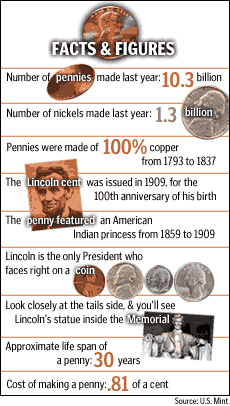
NEW YORK (CNN/Money) -
If you think a mere penny couldn't start much of a debate, think again. Arguments about the coin's future have lobbyists up in arms and has sparked a bill on Capitol Hill. The penny's potential fate even made it onto an episode of NBC's "The West Wing."
Everyone has to put in their two cents (sorry): Penny haters argue the coin is obsolete and costs more to make than it's worth. They think rounding purchases to the nearest nickel makes a better alternative (you'd pay a buck for 99-cent paper towels, and so on).
But supporters say the penny has a loyal fan base. A survey by Coinstar, a company that makes coin-exchange machines, said 65 percent of people polled favored keeping the penny in circulation. And some lobby groups -- Americans for Common Cents is just one -- say the rounding system would rip people off.
Still, you can't use a penny in most vending machines, or to pay your fare on most public transportation. If you pull out a handful of pennies to pay for something, you'll probably invite the scorn of the vendor, to say nothing of the people behind you in line.
Has the penny outstayed its welcome? (Take the poll to log your opinion and to see what other people think -- vote here.)
The penny problem
Representative Jim Kolbe (R-Ariz.), who proposed the Legal Tender Modernization Act, leads the charge against the penny in Congress. A senior member of the House Appropriations Committee, Kolbe has worked extensively on U.S. currency concerns, such as introducing the dollar coin.
At the center of his argument is the idea that making pennies costs more than the coins are actually worth.

"There's no profit whatsoever from making pennies, though the U.S. Mint will probably disagree," said Neena Moorjani, a spokesperson from Kolbe's office.
Indeed, the U.S. Mint does dispute the claim: It says making each penny costs about 0.81 of a cent, while it collects a whole cent for each one. The Mint's total profit on the penny: about $24 million a year.
"Penny manufacturing costs have gone up or down at times, but have been fairly steady the past few years," said Michael White, a spokesperson for the Mint.
Maybe, but pennies may add other costs, albeit less quantifiable ones. Jim Benfield, a spokesperson for the Coin Coalition, a lobby that wants the penny banished, thinks consumers ultimately pay for: 1) wrapping charges (the store pays about 60 cents for each roll of 50 pennies); 2) lost store productivity from penny users slowing the checkout line; and 3) lost wages paid to clerks counting pennies in the register on each shift.
"There's just a glut of pennies, and the U.S. Mint continues to crank more of them out," Benfield said. "Get rid of them."
Conflicts of interest
Each faction casts doubt on the other's math skills -- and the other's political supporters, as well.
Americans for Common Cents supports the idea that a rounding system would force prices up. They cite research by Raymond Lombra, an economics professor at Penn State University, who said a rounding bill would force an annual $600 million "rounding tax" on consumers.
| |
 Related stories
Related stories
| |
| | |
| | |
|
But the Coin Coalition said this study largely used items found in convenience stores, with prices ending mostly in 9. They argue that if you bought a bunch of items, then added in sales tax, you'd have a 50-50 shot at getting a price of, say, $15.82 -- which would round down for a savings of 2 cents.
"Their study presupposes you're only going to buy one item and that whatever you're buying isn't taxable. They've conveniently ignored multiple purchases and the randomizing effect of taxes," said Benfield.
And many note the interests of the copper and zinc industries. Pennies are made of 97.5 percent zinc, with a copper coating. To confuse you further, nickels aren't made of nickel -- they're actually made of 95 percent copper.
"Kolbe is from Arizona, the largest-copper producing state. The nickel is made predominantly of copper, as is the dollar coin, which he also supports. If we introduced a rounding bill, we would need more nickels. The whole proposal is special-interest lobbying at its worst," said Mark Weller, president of Americans for Common Cents.
The folks at the Coin Coalition counter that the zinc industry funds Americans for Common Cents.
So, which side will win the penny wars? It's ultimately in the hands of Congress, which must issue legislation if it wants to stop penny production. The first bill that suggested eliminating the penny and rounding to the nearest nickel, proposed by Rep. Jimmy Hayes (R - La.) in 1989, failed to be enacted into law.
So far, the future looks good for penny fans: the U.S. Mint has already made over 1 billion pennies this year, and hasn't received any order to stop, said White, the U.S. Mint spokesperson.
"We're just following orders from Congress," White said. "They haven't issued any legislation about discontinuing the one-cent coin, so we keep making them."

|

